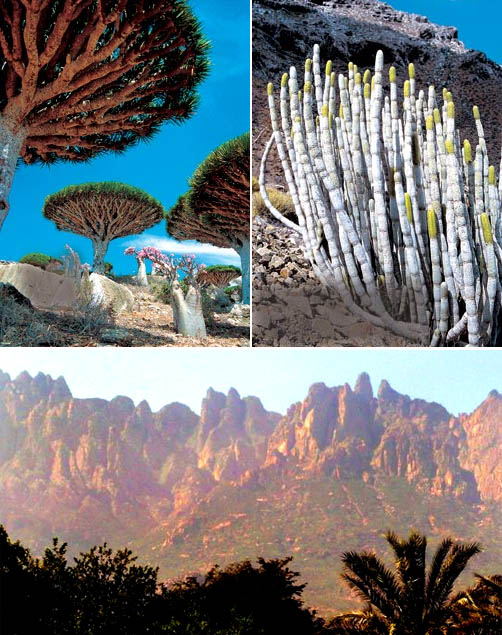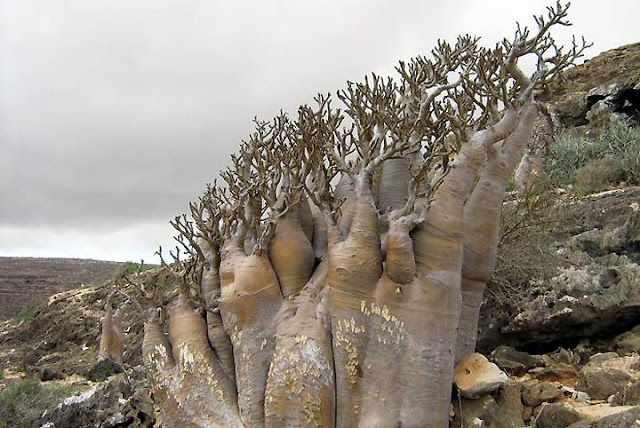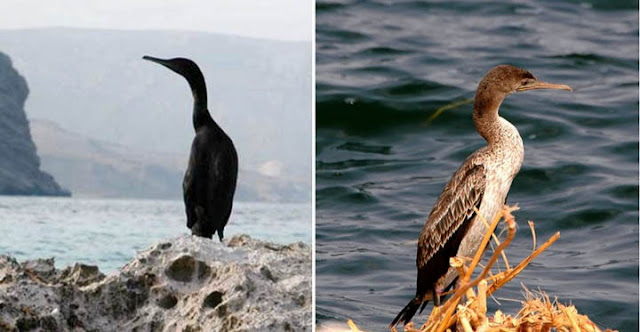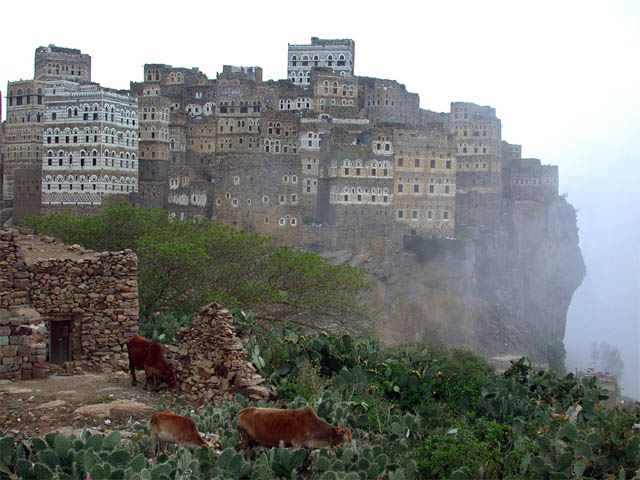Socotra Island: you have to see it to believe it
We covered some otherwordly places before (see, for example, The Bolivian Salt Lake, or The Richat Structure), but this island simply blows away any notion about what is considered "normal" for a landscape on Earth.
 |
| (images credit: Jan Vandorpe, socotra) |
Imagine waking up on the Socotra Island
and taking a good look around you (let's say your buddies pulled a
prank on you and delivered you there, and lets also assume that you
don't have any hangover from abuse of any substances). After a yelp of
disbelief, you'd be inclined to think you were transported to another
planet - or traveled to another era of Earth's history.
The second would be closer to the truth for this island, which is part of a group of 4 islands, has been geographically isolated from mainland Africa for the last 6 or 7 million years. Like the Galapagos Islands, this island is teeming with 700 extremely rare species of flora and fauna, a full 1/3 of which are endemic, i.e. found nowhere else on Earth.
The second would be closer to the truth for this island, which is part of a group of 4 islands, has been geographically isolated from mainland Africa for the last 6 or 7 million years. Like the Galapagos Islands, this island is teeming with 700 extremely rare species of flora and fauna, a full 1/3 of which are endemic, i.e. found nowhere else on Earth.
 | |
| (images credit: dianadrz, Irina Travina) |
 (image credit: socotra)
(image credit: socotra)
The climate is harsh, hot and dry, and yet
- the most amazing plant life thrives there. Situated in the Indian
Ocean 250 km from Somalia and 340 km from Yemen, the wide sandy beaches
rise to limestone plateaus full of caves (some 7 kilometers in length)
and mountains up to 1525 meters high.
 (image credit: Marco Pavan)
(image credit: Marco Pavan)
The name Socotra is derived from a
Sanscrit name, meaning "The Island of Bliss"... Is it the beaches? The
isolation and quiet? or the strange and crazy botanical allure?
Alien-looking plants: H. P. Lovecraft's secret inspiration?
Was the famous Chtulhu myths creator aware of these forbidding mountains with their hauntingly weird flora (think of plant mutations from his "The Color out of Space") ? We almost tempted to call Socotra the other "Mountains of Madness" - the trees and plants of this island were preserved thru the long geological isolation, some varieties being 20 million years old...
We begin with the dracena cinnibaris or Dragon's Blood Tree, the source of valuable resin for varnishes, dyes, and "cure-all" medicine; also (predictably) used in medieval ritual magic and alchemy -
Alien-looking plants: H. P. Lovecraft's secret inspiration?
Was the famous Chtulhu myths creator aware of these forbidding mountains with their hauntingly weird flora (think of plant mutations from his "The Color out of Space") ? We almost tempted to call Socotra the other "Mountains of Madness" - the trees and plants of this island were preserved thru the long geological isolation, some varieties being 20 million years old...
We begin with the dracena cinnibaris or Dragon's Blood Tree, the source of valuable resin for varnishes, dyes, and "cure-all" medicine; also (predictably) used in medieval ritual magic and alchemy -
The branches spread out into the sky and from below appear to hover over the landscape like so many flying saucers... and from above they have a distinct mushroom look:
There is also the Desert Rose (adenium obesium) which looks like nothing so much as a blooming elephant leg:
 (images credit: Jan Vandorpe)
(images credit: Jan Vandorpe) (image credit: Denis Romanov)
(image credit: Denis Romanov)
Dorstenia gigas - apparently does not require any soil and sinks roots straight into the bare rock:


(images credit: Jan Vandorpe)
It also has a distinct personality and likes to smile for the camera:
 (image credit: Tomas van Houtryve)
(image credit: Tomas van Houtryve)
Somewhat similar to the weird Dorstenia gigas, is this "bucha" vegetable, found as far north as Croatia. I hope it's not pregnant with anything malignant inside this sack. John Wyndham (with his "The Day of the Triffids") would've loved it:

(image credit: Damir)
Also found in Socotra's landscape is the ever-strange and extremely rare Cucumber Tree (dendrosicyos socotranum) - and yes, it's related to what's sitting in a pickle jar in your fridge:

(image credit: Jan Vandorpe)
Getting around can be a challenge, as there are almost no roads
Despite the fact that this island has around 40,000 inhabitants, the Yemeni govenment put in the first roads just 2 years ago - after negotiations with UNESCO, which has declared this island a World Natural Heritage Site. I would prefer a camel ride to what is bound to be a bumpy and slow 4x4 ride... It is a quiet and peaceful enclave in an otherwise troubled world. If you decide to visit there, you can forget about beachfront hotels and restaurants; this island is geared towards eco-tourism and sustaining the local economy and way of life. (images credit: Adele Obice, Marco Pavan, Denis Romanov)
(images credit: Adele Obice, Marco Pavan, Denis Romanov)

This island is a birder's paradise as well, with 140 different species of birds; 10 of which are not found anywhere else in the world. A unique Socotra warbler, sunbird, starling, bunting, sparrow and cisticola are among the ones found here. There are also Socotra Cormorants:

(images credit: Magellan Tours, Rafeek Manchayil)
Want to see some fairy-tale (and possibly haunted) shipwrecks? There are diving tours available... Hopefully some IMAX crew would film it in all its glory one day.

(image credit: socotra)
To give you a glimpse of Socotra's and Yemen's in general totally unique architecture, check out this place located on the mainland:
Al Hajarah, Yemen - Walled city in the mist
Computer game designers take note - this mysterious city in the foggy Yemen's Haraz Mountains can surely fire up imagination of anybody who decides to explore it:

(image credit: Jan Vandorpe)
 (image credit: Bellosta)
(image credit: Bellosta)

(image credit: Michaela Diener)
Dune? Clark Ashton Smith's Zothique? Pack your bags, for this is on our good old planet Earth, no interstellar visa required.

(image credit: Socotra)
SOURCE : http://www.darkroastedblend.com/2008/09/most-alien-looking-place-on-earth.html

(images credit: Jan Vandorpe)
It also has a distinct personality and likes to smile for the camera:
 (image credit: Tomas van Houtryve)
(image credit: Tomas van Houtryve)
Somewhat similar to the weird Dorstenia gigas, is this "bucha" vegetable, found as far north as Croatia. I hope it's not pregnant with anything malignant inside this sack. John Wyndham (with his "The Day of the Triffids") would've loved it:

(image credit: Damir)
Also found in Socotra's landscape is the ever-strange and extremely rare Cucumber Tree (dendrosicyos socotranum) - and yes, it's related to what's sitting in a pickle jar in your fridge:

(image credit: Jan Vandorpe)
Getting around can be a challenge, as there are almost no roads
Despite the fact that this island has around 40,000 inhabitants, the Yemeni govenment put in the first roads just 2 years ago - after negotiations with UNESCO, which has declared this island a World Natural Heritage Site. I would prefer a camel ride to what is bound to be a bumpy and slow 4x4 ride... It is a quiet and peaceful enclave in an otherwise troubled world. If you decide to visit there, you can forget about beachfront hotels and restaurants; this island is geared towards eco-tourism and sustaining the local economy and way of life.
 (images credit: Adele Obice, Marco Pavan, Denis Romanov)
(images credit: Adele Obice, Marco Pavan, Denis Romanov)

This island is a birder's paradise as well, with 140 different species of birds; 10 of which are not found anywhere else in the world. A unique Socotra warbler, sunbird, starling, bunting, sparrow and cisticola are among the ones found here. There are also Socotra Cormorants:

(images credit: Magellan Tours, Rafeek Manchayil)
Want to see some fairy-tale (and possibly haunted) shipwrecks? There are diving tours available... Hopefully some IMAX crew would film it in all its glory one day.

(image credit: socotra)
To give you a glimpse of Socotra's and Yemen's in general totally unique architecture, check out this place located on the mainland:
Al Hajarah, Yemen - Walled city in the mist
Computer game designers take note - this mysterious city in the foggy Yemen's Haraz Mountains can surely fire up imagination of anybody who decides to explore it:

(image credit: Jan Vandorpe)
 (image credit: Bellosta)
(image credit: Bellosta)

(image credit: Michaela Diener)
Dune? Clark Ashton Smith's Zothique? Pack your bags, for this is on our good old planet Earth, no interstellar visa required.

(image credit: Socotra)



Post a Comment